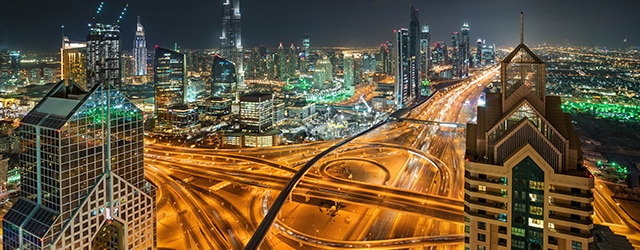Gulf Cooperation Council countries are fertile ground in which public-private partnerships may flourish to finance much-needed infrastructure investment. But the lack of legal and economic reforms remains an obstacle, and governments are skeptical of PPPs’ benefits for long-term projects.

“Build it and they will come” has been Dubai’s long-standing investment mantra. For years, the ambitious Gulf emirate has spent heavily on infrastructure, ultimately sealing its position as the region’s trading and investment hub. Even so, it now faces the same budgetary pressures felt throughout the Middle East, as falling oil revenues deplete government finances. After a sharp increase in 2016, ratings agency Standard & Poor’s says Middle East and North Africa (MENA) sovereign borrowing will decline 20% in 2017 to reach $136 billion. With financing constrained, analysts predict governments will increasingly turn to public-private partnerships (PPPs) to bridge funding gaps—expanding their use beyond power and water projects into social infrastructure.
PPP in the Middle East is not new; but it is not as widespread as many hoped, largely because governments have struggled to structure terms commercially attractive to the private sector and to dispel lingering doubts over transparency. Contractors and financial institutions have also criticized legal frameworks, but many governments are now responding by enacting legislation specific to PPP. Greater use of PPP is not just about balanced economics; it is also about safeguarding the cradle-to-grave social safety net pervasive in the Gulf Cooperation Council.
“Policymakers recognize the economic benefits of long-term PPP-availability-based payment structures for schools, health and transportation,” says Maarten Wolfs, partner and Middle East project and infrastructure finance leader at PwC. “Many of these projects must be delivered if governments wish to honor their social contract with citizens.”
Availability payments are a performance-based periodic payment for services covering capital and operating costs of the asset over time. The World Bank has urged MENA governments to make projects “investor-ready” by creating a balanced regulatory framework. Investor reservations aside, Kuwait, Oman, Qatar, Saudi Arabia and the UAE are tipped to be active PPP markets, while Egypt’s potential is reliant on reforms.

PPP ON THE RISE?
Of all the Middle East economies, Kuwait remains the most undiversified—about 60% of GDP and more than 80% of fiscal receipts are derived from hydrocarbon revenues, says S&P. That dependency prompted the government to pass a PPP law that came into force in 2015. The first phase of the project under the new law—the Az-Zour North Independent Water and Power Project—was completed in November. The project is 60:40 owned by the government and a private consortium.
Kuwait will likely use additional PPP after the government recently unveiled “New Kuwait,” an initiative that envisions a radical economic revamp to attract foreign direct investment. The long-term development plan through to 2035earmarks 164 projects to transform the emirate into a financial, petrochemical and cultural hub. The Kuwait Authority for Partnership Projects is also set to finalize four projects reportedly worth around $6 billion and has signaled it will tender several major PPP projects this year.
Saudi Arabia does not have a dedicated PPP law, but has “tendered PPP projects” under an existing procurement law. The kingdom may modify its personnel laws to improve the policy framework by allowing staff to be seconded to PPP projects, says law firm Hogan Lovells. Despite an absence of a stand-alone law, Saudi Arabia is potentially a major PPP market. Mohammed bin Salman, the youthful Saudi deputy crown prince, is leading efforts to shake up the kingdom’s economy as part of his Vision 2030 initiative, which analysts say will see more PPPs. According to Christopher Cross, a partner at Hogan Lovells Middle East, the Saudi Electricity Company has mandated that all future power plants in Saudi Arabia will be developed as PPPs.
Oman and Qatar are currently drafting legislation that should be enacted this year, according to Cross. Oman, which faces an acute budgetary squeeze and the prospect of a credit downgrade to non–investment grade, is planning to develop four new hospitals under PPP. Meanwhile, Qatar has already engaged in significant infrastructure spending ahead of the 2022 football World Cup and is considering PPP for its education and healthcare sectors.
Despite the absence of a federal PPP law, the UAE is attempting to strengthen the private sector. However, at the end of last year regional media reported that the government was intent on issuing a document granting private-sector companies the same rights and privileges as the public sector in engaging projects requiring financing. The emirate of Dubai passed its own PPP law in 2015, as it continues to spend heavily on transport infrastructure ahead of Expo 2020.
Elsewhere, Egypt’s deal with the International Monetary Fund (IMF) and the devaluation of the Egyptian pound are positive for investor sentiment. In February, the pound was the best performing emerging-market currency, rallying around 14% during the month. According to Capital Economics, the pound’s rebound was due to foreign investment and optimism that a $12 billion loan from the IMF will speed up much-needed economic reforms. Still, there remains significant political opposition, which may force the government to ditch or soften some policies. Corruption remains endemic; and despite hopes for the economy, recovery may yet be some way off.
Meanwhile, on a regional basis investors hope the procurement of the Gulf Railway project, also known as the GCC Railway, will use a PPP model. The mammoth 2,177 km multibillion dollar rail scheme will link the entire GCC region, yet no formal announcement has been made by other GCC partners regarding their preference for financing. Given previous problems encountered on overland rail projects, it may be difficult for developers to accept a full transfer of risk under PPP; and lenders will also be concerned about potential cost overruns associated with projects of this magnitude.
MORE QUESTIONS
Whether PPP gains momentum in MENA is tied partially to oil prices and governments’ fiscal position. It is true Egypt, Kuwait and Jordan have a PPP track record; yet major project-financing opportunities also lie elsewhere in the GCC. However, lingering uncertainties cast a shadow. “The time it takes to procure a project does not meet the timing expectations for regional procuring entities,” says Cross of Hogan Lovells, adding that there is not always a clear understanding by government procurement teams of the process and benefits of PPP.
International banks are also hesitant to lend to long-term projects, and regional governments have shown a preference to use existing revenues—both of which factors may hinder PPP.
Even so, in the intervening months PPP will be a litmus test for MENA governments’ commitment to economic diversification and willingness to open up markets. “Most countries in the MENA region that have stable governments with long-term national development programs are focused on diversifying their economies—PPP is one of the best ways to mobilize foreign direct investment,” says David Baxter, international development consultant, PPP specialist and former executive director of the Institute for Public Private Partnerships.



